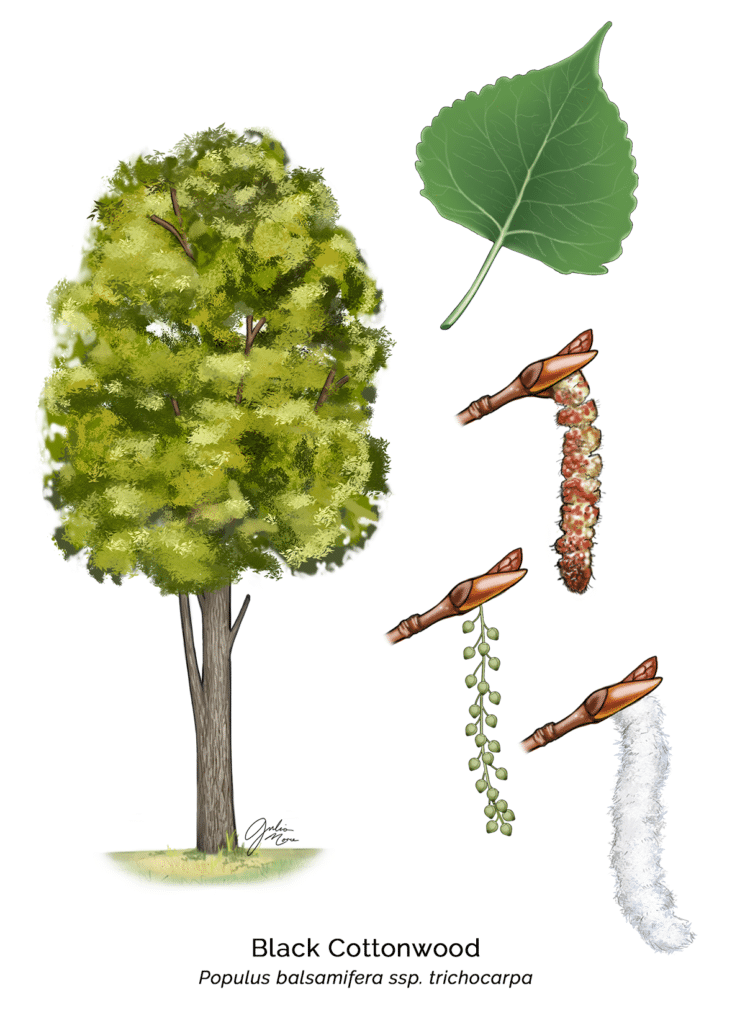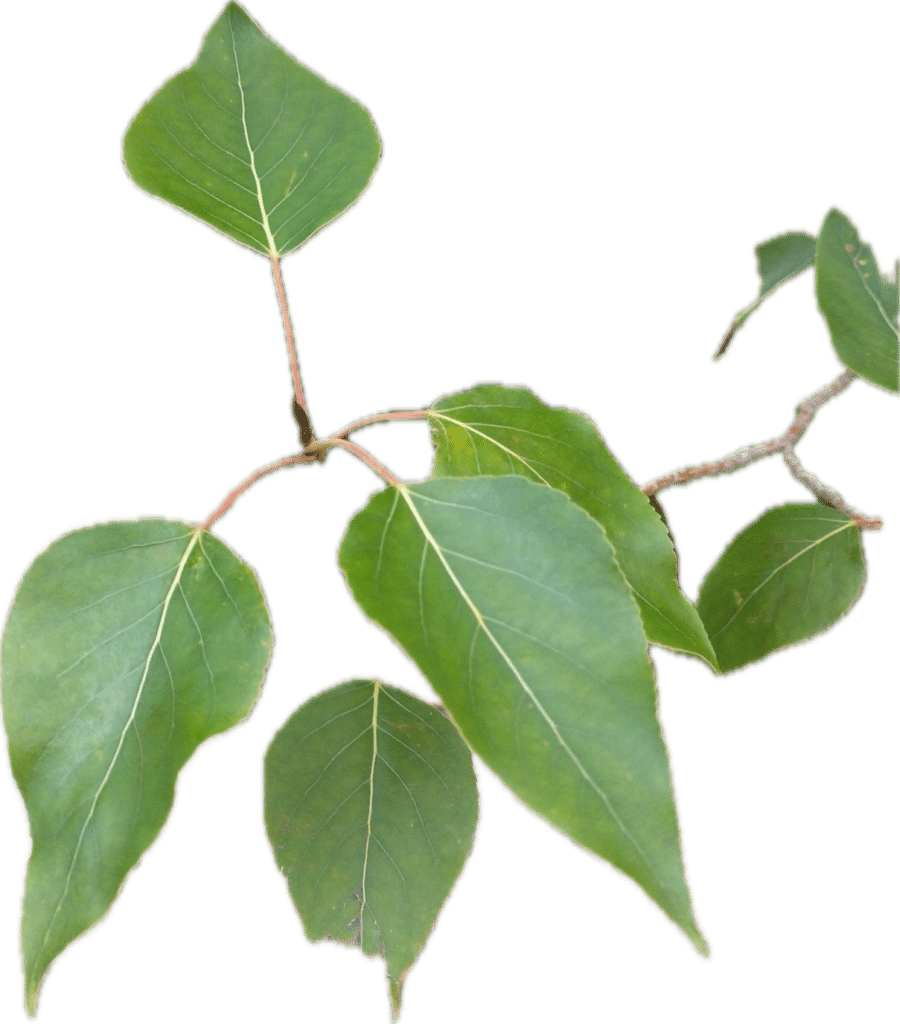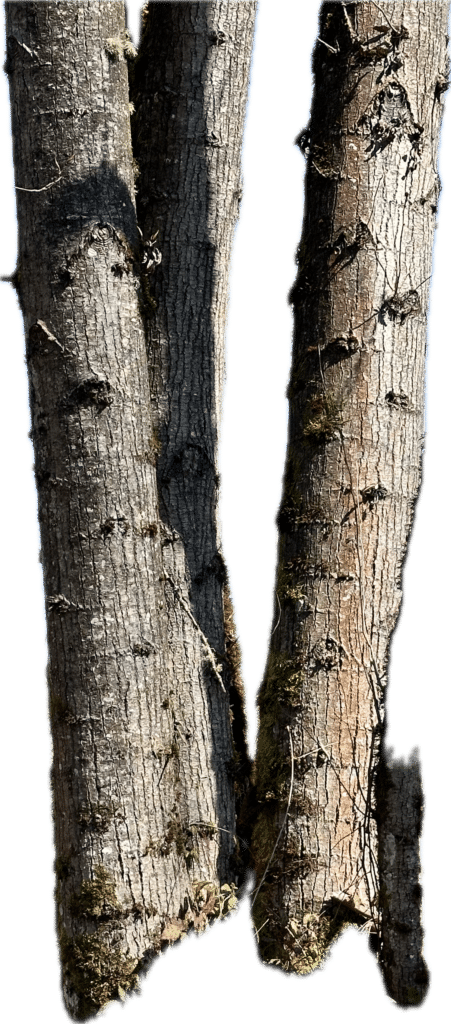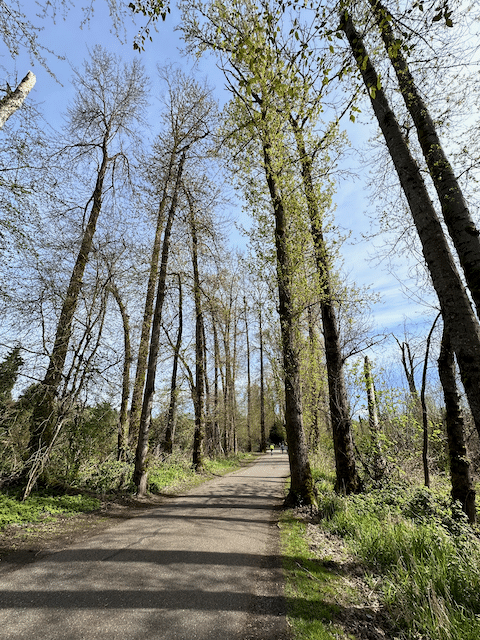Black cottonwood (Populus trichocarpa) is a large deciduous tree native to the Pacific Northwest, and its ecological significance in this region is multifaceted. This tree, part of the willow family, is one of the largest among some 40 species of Populus and is notable for being the tallest, fastest-growing hardwood in the western United States (1).

Identification
Black cottonwoods are relatively easy to identify using a combination of features including region, specific habitat, bark, leaves, and stature.
Another method for identifying cottonwood trees is to rule out alternatives. In western Washington, one should rule out bigleaf maple and red alder.
Leaves
Cottonwood leaves have a smooth, somewhat shiny surface. They are oval to heart-shaped with a point at the end. The edges are very slightly serrated.
Red Alder: leaves are heavily serrated
Bigleaf maple: leaves are lobed

Bark
The bark of black cottonwood trees is dark gray-brown with fissures or cracks.
Bigleaf Maple: Similar
Red Alder: Smooth and pale

Stature
Black cottonwood trees are fairly tall for a deciduous tree. They often grow with a single, straight primary trunk that does not fork until the upper section of the tree.
Red Alder: Sometimes similar, other times forking low on the tree
Bigleaf Maple: Sometimes similar. Often forks or branches lower on the tree forming a more rounded crown.

Range
Black cottonwood has an extensive range, growing from Kodiak Island in Alaska to northern Baja California, and eastward to the Rocky Mountains in Idaho, Montana, and Canada. It is most abundant in the Puget Sound basin and the Columbia and Willamette river basins in the Pacific Northwest. It thrives in both humid and arid climates, and its growth is best on deep alluvial soils with good aeration and abundant moisture, though it is limited by high soil acidity, inadequate aeration, and low nutrient supplies (2).
The easiest way to find cottonwood trees is to find trees near water. Riverside trails and paths are a great place to find cottonwood trees.

Ecological Role
Riparian Ecosystems and Soil Stabilization:
Black cottonwood is crucial for stabilizing riverbanks and preventing erosion, particularly in riparian areas. Its extensive root systems help maintain soil integrity, crucial for mitigating the effects of flooding.
Biodiversity and Habitat:
This species is a pioneer in colonizing areas disturbed by floodwaters. It provides essential habitats for wildlife, including birds, mammals, and insects. The tree’s cavities offer nesting sites, and its leaves and buds are a food source for various species.
Associations with Other Species:
Black cottonwood commonly occurs in mixed stands with several species of willow, red alder, Oregon ash, bigleaf maple, Douglas-fir, and others, playing a vital role in the biodiversity of these ecosystems.
Adaptation and Growth:
The tree is intolerant of shade but maintains dominance in the canopy through superior growth rates. It is specifically adapted to dominate areas disturbed by floods and colonizes disturbed upland sites with adequate moisture.
Regeneration and Propagation:
Black cottonwood begins to produce seed at about 10 years of age and generally produces abundant seed crops every year. It also sprouts readily from stumps or buried branch fragments, aiding in its rapid spread and regeneration in suitable habitats.
Environmental Buffering:
It has a high nitrate uptake, making it useful for buffering agricultural areas against pollution (3).
Ethnobotanical and Commercial Significance:
Black cottonwood has been traditionally significant to the Coast Salish people, who used its resin for medicinal purposes. The inner bark was used as food, and old dead leaves were used in baths for treating body aches and stomach problems. Today, it is used commercially for particle board, plywood, and veneer
(Pojar, J and MacKinnon, A. 2004. Plants of the Pacific Northwest Coast: Washington, Oregon, British Columbia and Alaska. Vancouver (BC): Lone Pine Publishing.)
Conservation Concerns
Black cottonwood faces challenges such as habitat loss, invasive species, and changes in water management. Conservation efforts are focused on protecting riparian zones, restoring degraded habitats, and promoting sustainable land-use practices.
Black cottonwood is a vital component of the Pacific Northwest’s ecological and cultural landscape. Its role in habitat creation, biodiversity support, ecosystem stability, and environmental buffering, coupled with its traditional and commercial uses, underscores its importance in this region.
Black Cottonwood Distribution in Washington
